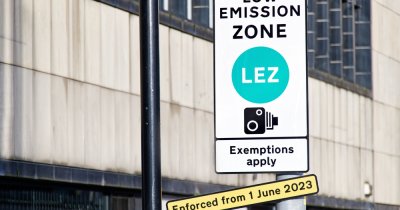As far as electrification goes, there are multiple startups and even large energy companies, including gas station operators, that install their own charging stations. One of the more recent initiatives to electrify important cargo hubs in Europe belongs to Milence, an electric truck charging joint venture between Daimler Truck, the Traton Group and the Volvo Group, who recently opened the company's first truck charging hub in France and its second charging site so far in Europe.
The charging hub implemented by Milence in France is located near an important logistics route used by trucks that travel between Paris and larger cities in Normandy, such as Le Havre and Caen. Located four minutes away from the highway, the charging hub offers four points for large commercial vehicles, with a total power of 400kW via the CCS interface.
CCS or combined charging system is crucial for juicing up larger batteries, since it can pump a greater amount of energy in the battery packs of vehicles. For trucks, which can easily pack batteries with a size of hundreds of kWh, this can take down charging times significantly. Additionally, megawatt charging systems (MCS) are an emerging solution for filling the cells of these vehicles.
By the end of 2027, Milence aims to install 1.700 charging points across Europe's heavy-duty road network to support the adoption of battery-powered trucks, while this network is expected to span across 15 different countries by the same year.
Optimized power delivery
Of course, charging these vehicles can ideally be done with the help of renewable power, so that the carbon footprint can be lowered further and the energy grid, less strained.
Ireland-based GridBeyond offers solutions that help address some of the issues associated with the adoption of renewable energy, such as the intermittent energy delivery from solar or wind sources, which may fall short of the peak demand situations.
The platform uses multiple kinds of predictive data, from weather to price information, to help manage the way energy is distributed.
The Irish company experienced significant growth back in 2023, when the company expanded its team, doubling the number of employees globally, and acquired Veritone Business Energy. Over the past three years, the Irish company grew its revenues by 70% per year, with a similar growth rate expected for 2024, as well.
By optimizing power delivery from renewables, we can help balance the grid and avoid blackouts, which can be an issue when charging electric vehicles, as charging stations are not yet available in very large numbers.
Hydrogen-powered trains, the future of long-distance public transport
There are some companies, such as Siemens, that experiment with battery-powered trains, which can have an advantage on routes that are semi-electrified, meaning that power lines may not be available throughout the entire track.
Train-specialized manufacturer Stadler developed the Flirt 2, a hydrogen-powered train, which according to the company, surpassed the 2.800 kilometers mark on a single refill, significantly overpassing Alstom's record of 1.175 kilometers in 2022.
Switzerland-based Stadler has another record under its belt, when it drove a battery-electric train over a distance of 224 kilometers in Germany.
If hydrogen trains will become a focus of major companies, then this solution could prove more effective than battery-powered units, as filling the hydrogen tanks would be much faster, compared to filling the large batteries required to power a locomotive.
Of course, the hydrogen infrastructure will also need to be properly developed for this to be successful, with green and pink hydrogen being the preferred alternatives. Learn more about the colors of hydrogen and which are the ones we should pursue here.
 Mihai - Cristian Ioniță
Mihai - Cristian Ioniță












Any thoughts?